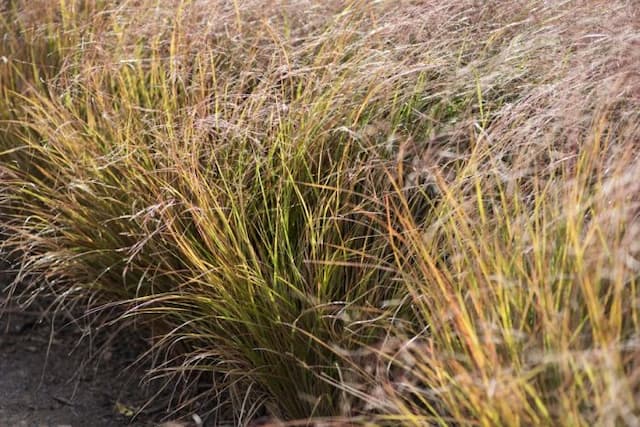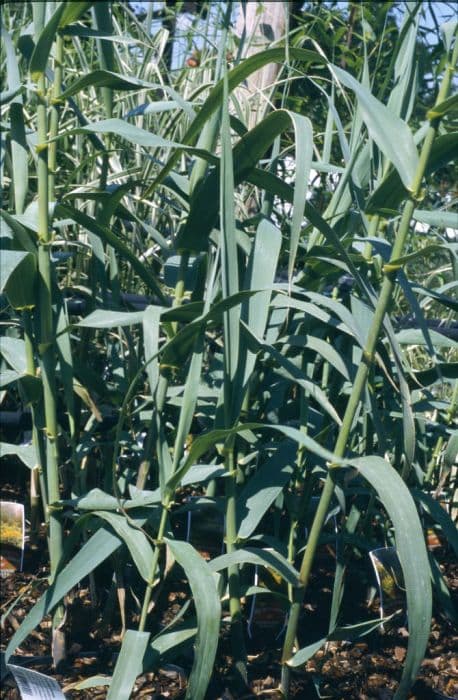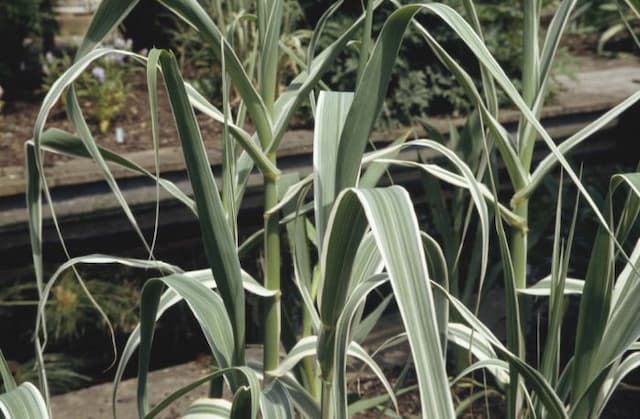Cortaderia richardii (Endl.) Zotov











ABOUT
Cortaderia richardii, commonly known as toetoe, is a perennial grass native to New Zealand. It features long, arching, green leaves that have sharp edges, which can create a fountain-like appearance. The foliage often forms a dense, tussock-like clump from which the flower spikes emerge. Toetoe is known for its striking and feathery flower plumes, which are creamy white to pale brown in color. These plumes are held aloft on sturdy stems that rise above the foliage, providing an impressive display that can sway gracefully in the wind. After the blooming period, the flowers turn into fluffy, cotton-like seeds. This characteristic appearance of its flower plumes is often associated with ornamental grasses and contributes significantly to its popularity in landscaping.
About this plant
 Names
NamesFamily
Poaceae
Synonyms
Toetoe, South Island Toe Toe, Toi
Common names
Arundo conspicua, Arundo richardii, Cortaderia conspicua, Cortaderia richardii, Danthonia argentea, Gynerium argenteum, Gynerium conspicuum, Gynerium richardii, Lamprothyrsus hieronymi, Stipa arundinacea.
 Toxicity
ToxicityTo humans
Cortaderia richardii, commonly known as toetoe, is not known for its chemical toxicity to humans. However, the physical structure of the plant can be harmful. The edges of the leaves are very sharp and can cut skin, while the fine hairs can irritate the eyes, skin, and throat if they come into contact with them.
To pets
For pets, Cortaderia richardii, or toetoe, does not possess notable chemical toxins that would cause poisoning upon ingestion. Nevertheless, as with humans, the physical characteristics of the plant can cause harm. Pets can suffer from cuts in the mouth or digestive track due to the sharp leaf edges, and irritation from the hairs can affect their eyes and skin if contact occurs.
 Characteristics
CharacteristicsLife cycle
Perennials
Foliage type
Evergreen
Color of leaves
Green
Flower color
Varies
Height
6 feet (1.83 meters)
Spread
4 feet (1.22 meters)
Plant type
Grass
Hardiness zones
8
Native area
New Zealand
Benefits
 General Benefits
General Benefits- Landscape design: The tall and elegant form of toe toe can be used as a focal point in garden design or for creating screens and barriers.
- Wildlife habitat: Toe toe provides shelter and nesting sites for birds and small animals.
- Erosion control: The deep root system of toe toe can help to stabilize slopes and prevent soil erosion.
- Windbreak: The dense growth of toe toe can act as a windbreak, protecting other plants and reducing wind speed in exposed areas.
- Ornamental use: Toe toe's feathery plumes are often used in floral arrangements and as dried ornamental features.
- Cultural significance: For indigenous cultures, such as the Maori, toe toe holds traditional value and can be used in crafts and ceremonies.
- Drought resistance: Toe toe is adapted to withstand periods of dryness, making it suitable for xeriscaping or gardens with low water availability.
 Medical Properties
Medical PropertiesThis plant is not used for medical purposes.
 Air-purifying Qualities
Air-purifying QualitiesThis plant is not specifically known for air purifying qualities.
 Other Uses
Other Uses- Cortaderia richardii, commonly known as Toetoe, can be used in landscaping for ornamental purposes; its tall, feathery plumes add aesthetic beauty to gardens and parks.
- Toetoe fibers can be used in traditional weaving practices by indigenous peoples of New Zealand to create mats, baskets, and other decorative items.
- The tall structure of Toetoe makes it suitable for use as a natural windbreak or hedge in coastal areas where it can withstand harsh winds.
- Its dense growth can provide habitat and nesting materials for some bird species, contributing to local biodiversity.
- Dried plumes of Toetoe can be used in floral arrangements and as decorations in arts and crafts due to their feathery texture and resilience.
- The plant's root system can contribute to soil stabilization, particularly on slopes and banks where erosion control is needed.
- Toetoe can act as a privacy screen when planted in a row, creating a natural barrier between properties or along boundaries.
- Due to its distinctive appearance, Toetoe can be used as a motif in cultural artwork, symbolism, and design in New Zealand.
- The seeds of the Toetoe may be used as a food source for some birds and insects, supporting the local ecosystem.
- When dried, the stems of Toetoe have been historically used for thatching roofs in traditional Maori buildings.
Interesting Facts
 Feng Shui
Feng ShuiThe plant Cortaderia richardii, commonly known as Toetoe, is not used in Feng Shui practice.
 Zodiac Sign Compitability
Zodiac Sign CompitabilityThe plant Toetoe is not used in astrology practice.
 Plant Symbolism
Plant Symbolism- Strength and Resilience: Cortaderia richardii, commonly known as New Zealand Toetoe, is known for its capability to withstand harsh conditions and grow in tough environments, thus symbolizing the ability to endure and thrive amidst adversity.
- Flexibility: The flowing nature of its feathery plumes, which gracefully move with the wind, embodies adaptability and the importance of bending without breaking when faced with challenges.
- Protection: Traditionally, Toetoe was used by indigenous Maori in New Zealand to create shelter and bedding, hence it represents a sense of shelter and safety.
- Unity: The dense growth habit of Toetoe, where multiple stems rise from a single base, may symbolize unity and standing together with strength in numbers.
- Heightened Awareness: With its tall and prominent stance, Toetoe can signify being able to see from a higher perspective, suggesting an elevated level of understanding or awareness.
 Water
WaterThe Toetoe should be watered deeply, ensuring that the soil is moistened thoroughly. This plant prefers consistent moisture but not waterlogged conditions, so it's important to let the top inch of soil dry out before watering again. Typically, watering once every week with one to two gallons, depending on weather conditions like heat and wind that may accelerate soil drying, is sufficient. During the growing season in spring and summer, you may need to water more frequently, but always check soil moisture before doing so. In winter, reduce the frequency of watering to every other week or less, as the plant's water needs decrease.
 Light
LightToetoe thrives in full sunlight, so it is best to position it in a spot where it can enjoy at least six hours of direct sunlight daily. The ideal location for Toetoe would be in a south-facing area if located in the northern hemisphere, ensuring maximum exposure to sunlight. These plants can tolerate partial shade, but they grow best and produce more robust plumes when they receive ample sunlight.
 Temperature
TemperatureToetoe can handle a range of temperatures and are hardy, but they prefer conditions that hover between 60°F and 75°F for optimal growth. They can survive minimum temperatures of around 20°F, but frost may damage the foliage. The maximum temperature for Toetoe typically shouldn't exceed 90°F as extremely high temperatures can stress the plant. For best results, plant in an area that experiences temperate conditions without extreme cold or heat.
 Pruning
PruningToetoe should be pruned to remove old foliage and encourage fresh growth. Pruning is best done in the late winter before new growth starts, usually just once per year. Cut back the foliage to about a foot to stimulate new growth in spring. This also helps maintain the plant's shape and remove any damaged or dead material from the previous growing season.
 Cleaning
CleaningAs needed
 Soil
SoilThe Toetoe needs well-draining soil with a slightly acidic to neutral pH, ideally between 5.5 to 7.0. An ideal mix would be a combination of loamy soil, peat, and sand to ensure proper drainage and aeration.
 Repotting
RepottingToetoe, being a large grass, does not require frequent repotting and can be repotted every 2-3 years or when it outgrows its current container.
 Humidity & Misting
Humidity & MistingToetoe thrives in moderate to high humidity levels but is quite adaptable and can tolerate a range of conditions, avoiding extremely dry air.
 Suitable locations
Suitable locationsIndoor
Place Toetoe in a bright spot, away from direct strong sun.
Outdoor
Plant Toetoe in full sun to part shade and shelter from strong winds.
Hardiness zone
7-10 USDA
 Life cycle
Life cycleThe life of the plant commonly known as the South Island Toe Toe (Cortaderia richardii) begins with seed germination, which requires a suitable combination of temperature, moisture, and light to initiate. Once the seed has germinated, the plant enters the seedling stage, characterized by the growth of a small rosette of leaves close to the ground. As the plant matures, it develops into a tussock-forming grass, with numerous long, narrow leaves that can reach substantial lengths. The vegetative phase is prolonged, during which the plant continues to grow and increase in size. The reproductive stage follows, where the South Island Toe Toe produces large, feathery plumes that are actually panicles of tiny flowers, which can be especially prominent and ornamental in the summer and autumn. After pollination and seed set, the cycle can begin anew when the seeds are dispersed, often by wind, to new locations where they may germinate.
 Propogation
PropogationPropogation time
Spring-Early Summer
Cortaderia richardii, commonly known as South Island Toe Toe, is typically propagated by division, which is the most popular method for this species. This process involves separating the dense clump of root systems, usually in late winter or early spring before new growth commences. To propagate by division, gardeners dig up the entire plant, taking care to preserve as much of the root system as possible. The clump should then be carefully divided into smaller sections, which can be done using sharp spades or knives. Each section must have a portion of the root mass along with several growing points. These divided sections are then replanted at similar depths to which they were originally growing, spaced at intervals to allow for future growth, typically about 3 to 6 feet apart (approximately 0.9 to 1.8 meters). After replanting, the divisions should be well-watered to establish them in their new locations.









